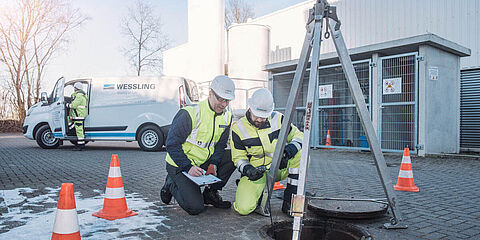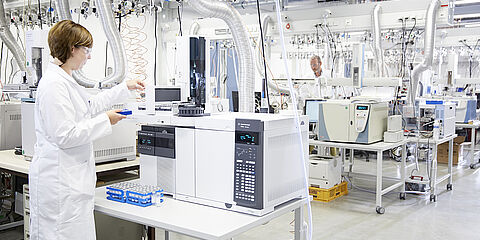Nanomaterials – consulting, analysis and assessment
Thanks to extensive experience in the field of nanoanalysis, we advise customers in the cosmetics, textile, electrical, pharmaceutical and chemical industries. We focus on nanoanalytical investigations, safe handling of nanomaterials in production and on all legal issues.

In addition, we characterise nanomaterials by precise analysis and determine whether a material, a raw material for example, is present as a nanomaterial.
Nanomaterials are playing an increasingly important role in industry,due to the fact that they give products new properties that are not possible with the same materials when their particle size is of a higher order of magnitude. Health and environmental protection, and hence the safe handling of nanomaterials, are also becoming increasingly important. Manufacturers, the processing industry and users of nanomaterials have a responsibility to ensure a high safety standard for consumers and employees.
Thanks to extensive experience in the field of nanoanalysis, WESSLING experts can provide you with competent advice and support with a wide range of services. The focus is on highly qualified consulting and analysis services specifically geared towards your individual requirements.
Our services in detail
Our services in detail
Nanomaterials in cosmetics
Nanomaterials in cosmetics
Legislation has laid down specific requirements for nanomaterials in the EU Cosmetics Regulation. Special assessment and notification requirements apply to cosmetic products with intentionally added, insoluble nanoscale constituents. We will help you meet these requirements with advice and analysis in our laboratories.

Micelle analysis for cosmetics and pharmaceutical products
The use of active ingredient delivery systems in cosmetics and pharmaceutical products is growing in importance, particularly in skincare products. The active ingredient systems consist of biodegradable, readily soluble nanostructures. These include micelles, liposomes, nanoemulsions and lipid nanoparticles, which have a high cleaning effect.
Our highly qualified consulting service is tailored to your requirements. The analysis of micelles is an interdisciplinary topic shared by nanotechnology experts and cosmetics and pharmaceutical experts. We test how high the concentration of a raw material must be to form micelles and determine their number in the final product.
Our services in the field of micelle analysis:
- Quality analysis of raw materials at a nanoscale and a micron scale
- Comprehensive advice on the provisions of EU Cosmetics Regulation (EC) No. 1223/2009 relating to the nanomaterials used
- Independent assessment and evaluation of your product with regard to the potential incorporation of nanomaterials
- Determination of the critical micelle concentration (CMC concentration)
- Analysis of emulsions containing micelles using cryo-scanning electron microscopy
- Analysis of size distribution and homogeneity using dynamic and static light scattering
- Determination of the critical micelle concentration (CMC)
Our services in detail
REACH
REACH Regulation: Clear rules for nanomaterials
Since the REACH Regulation (European Chemical Regulation) was developed and drafted, there have been clear rules for nanomaterials along the entire supply chain. In future, manufacturers, importers and users must submit detailed data on nanomaterials and their nanoforms when they are registered with the European Chemicals Agency (ECHA).
Our services within the context of the REACH Regulation
- Advice on product registration with the European Chemicals Agency (ECHA)
- Chemico-physical characterisation of nanomaterials
- Risk assessment of nanomaterials
We are at your disposal for particular questions regarding the analysis of substances in connection with REACH. Read more about our services in the field of chemical safety and REACH here.
Further information for download
Your contact regarding REACH and nanomaterials
We will be happy to support you.
- André Schmitz
- +49 2505 89-673
- andre.schmitz@wessling-ce.de

Our services in detail
Safe handling of nanomaterials
Risk assessment: Safe handling of nanomaterials in the workplace
According to the Occupational Health and Safety Act, it is the duty of every employer to protect their employees from potential hazards. WESSLING experts aid companies of the chemical, cosmetics, food and pharmaceutical industries – both manufacturers and processors of inorganic raw materials and other materials in powder form – in identifying potentially hazardous nanomaterials and carry out a risk assessment in accordance with the current regulations.
Substances and mixtures consisting of manufactured nanomaterials may be hazardous substances, but this is not necessarily the case. The same applies to substances and mixtures that contain manufactured nanomaterials. Risk assessment is the key element of occupational health and safety, on the basis of which, among other things, the necessary health and safety measures are derived and implemented. Appropriate, documented protection from the above-mentioned substances and mixtures is therefore ensured.
Hazardous Substances Ordinance (GefStoffV) and Technical Regulations for Hazardous Substances (TRGS)
The handling of hazardous substances is regulated by law. Thus, according to § 6 of the Hazardous Substances Ordinance (GefStoffV) , the employer must determine, within the scope of the above-mentioned risk assessment, whether employees are engaged in activities with hazardous substances or in activities where hazardous substances may be produced or liberated. In assessing the risks to employees, factors such as hazardous properties, manufacturer information, exposure and working conditions must be taken into account.
As a further, more specific regulations publication, the Technical Regulations for Hazardous Substances (TRGS) are binding here for example, the TRGS 400 "Risk assessment of activities with hazardous substances". In addition, the Committee for Hazardous Substances (AGS) publishes recommendations for protecting the health and safety of employees, which when applied give the employer the certainty that the state of the art and current occupational health and hygiene standards, etc. have been duly taken into consideration.
Our services for safe handling of nanomaterials:
- Advice on health and safety in the workplace according to TRGS 527 – activities with nanomaterials
- Carrying out a risk assessment according to TRGS 527
- Identification of materials using the latest nanoanalytical methods
Our services within the field of air monitoring and measuring stations.
Further information for download
Your contact for safe handling of nanomaterials in the workplace
We will be happy to support you.
- André Schmitz
- +49 2505 89-673
- andre.schmitz@wessling-ce.de

WESSLING expertise for nanoanalytical investigations
The characterisation of nanomaterials requires a combination of different analysis techniques that depend on the particular question under consideration. Parameters such a size, form and structure as well as size-dependent photonic properties and chemical composition play a big role in quality assurance.
Characterisation of nanomaterials
The investigation of nanomaterials in different matrices, for example cosmetics, is very demanding. Based on our excellent network with universities and institutes, we are also able to solve complex and challenging problems. Nanomaterials can be present in the form of particles or fibres. At least one dimension is smaller than 100 nanometres. By way of comparison: the ratio between a nanoparticle and a football is about the same as that between a football and the Earth.
Our specific nanoanalysis techniques
- Scanning electron microscopy (FE-SEM/EDX)
- Transmission electron microscopy (TEM/EDX)
- Dynamic light scattering (DLS)
- Laser diffraction (static light scattering) according to ISO 13320-1
- Nanoparticle sizer (SMPS) (measurement of airborne particles)
Our services
- Material and particle analysis: physical and chemical characterisation on a micro- and nanometre scale
- Chemical safety: Consulting on nanomaterials with regard to REACH
- Support in the assessment of nanomaterials according to the legal requirements applicable to, for example, cosmetic products and foodstuffs
- Advice on activities with nanomaterials according to TRGS 527
- Monitoring of indoor air quality, including ultrafine particles (UFP)
- Project-based development of new methods for the identification of nanomaterials in the environment (waste water, surface water, fine dust, UFP)
- Ecotoxicological analysis according to ISO standards and OECD guidelines
Your contact regarding nanomaterials
We will be happy to support you.
- André Schmitz
- +49 2505 89-673
- andre.schmitz@wessling-ce.de









